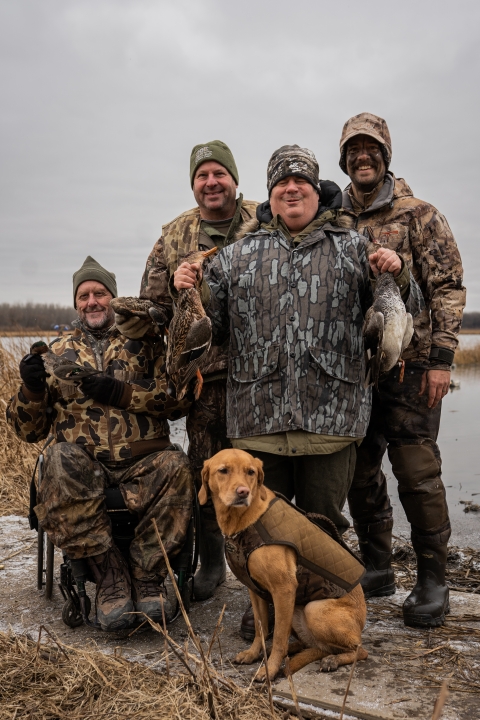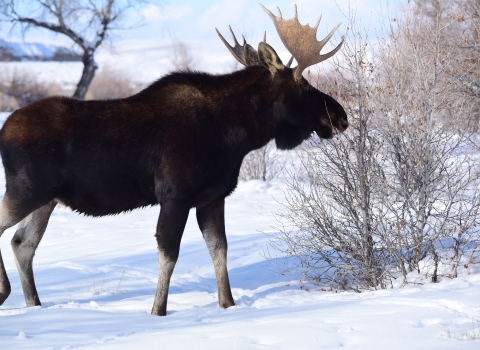Hunting on national wildlife refuges is a tradition that dates back to the early 1900s. While more than 330 refuges are open to the public for hunting across the country, we at the U.S. Fish and Wildlife Service are focused on holding space for people who use adaptive equipment like shooting mounts, specialized triggers and all-terrain wheelchairs to hunt, and we're working to remove access barriers on public lands more broadly. Take a moment to learn about how Minnesota Valley National Wildlife Refuge has been welcoming people of all backgrounds and abilities to experience quality hunting that’s within reach of the Twin Cities.
For more than two decades, Capable Partners, a Minnesota-based hunting organization, has been rallying hunters with disabilities together to build a community that connects people with the great outdoors. Most folks come from the Minneapolis-St. Paul metropolitan area, but membership also extends to central and western Minnesota. The group aims to provide opportunities for personal growth and independence for people with physical challenges in coordination with guide partners and other support volunteers who aid in fishing, hunting and other related outdoor activities.
While assistive technology is a part of the hunting experience for folks with mobility issues, a quality hunt requires much more than gear - it requires people. Working with the dedicated staff and volunteers, hunters love being out in nature. While some participants come with little or no hunting experience, many doubt they would have even taken up the challenge of waterfowl hunting if not for the Capable Partners program.
Hunter Evan Newton reflects, “Furthermore, as a quadriplegic, I cannot get out hunting without the help of volunteers, who help me shoulder my shotgun, load it, and turn off the safety. It's also important to have the infrastructure available to make my hunting experience safe. I have never hunted waterfowl anywhere else.”
Hunt organizers note that this empowerment is tangible at every outing, and that together folks find solutions that make what seemed impossible a reality. What does it take to provide a safe, quality hunt?
What makes a quality hunt?
Having a large geography with clear boundaries is essential for any hunt. While special waterfowl hunts in the area date back to the 1980s, the refuge team really grew the offerings in the early aughts by expanding from one waterfowl site to include the entirety of Big Rice Lake and all of Blue Lake for waterfowling. In addition, the refuge added archery deer hunting on three refuge units.
“Minnesota Valley National Wildlife Refuge is literally in the heart of one of the largest metropolitan areas in the nation—not in the outskirts or a two-hour drive—making it a very easy place to commute to as well,” said Capable Partners Vice President Chad Fix.
Fix goes on to explain that having places that are close to home is a godsend to people who have mobility limitations. “This is why we’re so grateful at Capable Partners that the refuge has opened their doors to us. We’d argue it’s the best public access on the planet,” notes Fix.
Wildlife Refuge Specialist Chris Kane and program coordinator notes that these more expansive managed hunts are conducted in areas of the refuge that are normally closed to hunting that gives more space to determine how folks set up their experience.
“This expansion of the hunt program has very much empowered these hunters to be able to determine their own success,” said Kane. “Many of them were hunters before they came to this challenge in their life and didn’t believe they would ever be able to hunt again. To once again experience the freedom of being outdoors, despite these obstacles, is no less than cathartic for them,” continued Kane.
Finding and removing barriers
Minnesota Valley National Wildlife Refuge works to give every community in the Twin Cities area an opportunity to have a meaningful connection and feel included in a recreational experience. By identifying the barriers that prevent someone from accessing that activity and working to eliminate that hurdle, the refuge team welcomes people to get out and explore. For some communities, it may be a physical barrier, while for others it may a cultural one. As a community partner, the refuge team works hard to make connections that better help them to understand barriers, because they are unique to each community.
While hunting is considered a traditional use of National Wildlife Refuge System lands and waters, only a fraction of visitors get the opportunity to learn how to hunt safely there. When you partner with a group like Capable Partners, you can empower a new generation, or an entirely new demographic of people, to try something they may not have done before. Providing that experience in a way that makes someone feel welcome, confident and in tune with the natural spaces in their backyard is the refuge’s goal.
“When people feel empowered and enjoy their time in nature, they want to come back and become stewards of that resource,” notes Refuge Manager Eric Mruz. “We want everyone to feel that connection to the refuge.”
Every time we remove a barrier, we can provide an opportunity for someone to have a meaningful experience and feel connected with the nature around them. It is important to note that this is a partnership in every sense of the word. The refuge couldn’t implement this program on our own and doesn’t have all the resources that are needed to accomplish this program unilaterally. Capable Partners has been instrumental in making this program a success. The myriad of volunteers who guide hunters, maintain and build infrastructure, and work with the refuge staff is the engine that keeps this program alive. Interested folks can reach out to the refuge for more information or to Capable Partners, who welcome non-members to many events.
Learn more about Minnesota Valley National Wildlife Refuge and plan your visit today!





